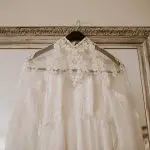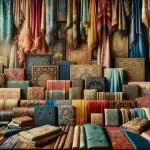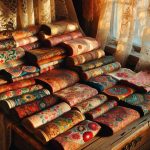Did you know that over 60% of fashion enthusiasts have incorporated vintage fabrics into their wardrobes in the past year? As you explore this growing trend, you'll find that vintage textiles offer more than just a nostalgic appeal; they bring a unique charm and history to modern designs. Whether you're drawn to intricate lace or bold geometric patterns, there's a vintage fabric that can elevate any look or space. If you're curious about how to identify quality pieces or incorporate these timeless materials into your style, there's much more to uncover.
Table of Contents
Key Takeaways
- Vintage fabrics are making a stylish comeback, blending nostalgic charm with modern fashion trends.
- Floral prints, geometric shapes, and retro stripes are reemerging in contemporary designs, reflecting past and present fusion.
- Incorporating vintage fabrics in fashion offers unique, timeless pieces that add sophistication and versatility.
- Sustainable fashion trends highlight the eco-friendly benefits of using vintage fabrics, promoting upcycling and ethical production.
- Thrift shops, estate sales, and online platforms provide rich sources for discovering quality vintage textiles.
History of Vintage Fabrics
Vintage fabrics have a rich history that dates back to centuries, capturing the essence of different eras and their unique styles. You'll find that antique textiles are more than just old pieces of cloth; they're a window into the past, reflecting the cultural and technological advancements of their time.
From the intricate tapestries of the Middle Ages to the luxurious silks of the Renaissance, each period brought its own innovations in textile evolution.
By exploring antique textiles, you'll gain insight into how different civilizations wove their stories into the very fabric of their lives. Ancient Egyptians, for instance, mastered linen production, while the Chinese developed silk weaving techniques that remain unrivaled even today.
As you immerse yourself further, you'll notice how the Industrial Revolution marked a significant turning point in textile evolution, introducing mechanized looms and mass production.
Understanding the history of vintage fabrics helps you appreciate the craftsmanship and artistry that go into each piece. It's fascinating to see how different materials, dyes, and weaving techniques evolved over time, influenced by trade, technology, and societal changes.
Embracing this rich history not only enhances your knowledge but also deepens your connection to these timeless treasures.
Popular Vintage Patterns
You'll notice that vintage patterns are making a strong comeback in today's fashion. Floral prints are experiencing a renaissance, geometric shapes are once again popular, and retro stripes are regaining their appeal.
Let's explore how these patterns are influencing modern styles.
Floral Print Renaissance
Amidst the resurgence of vintage fabrics, floral prints are making a bold and stylish comeback. You can breathe new life into these classic patterns by incorporating them into your DIY projects.
Think beyond the traditional uses and add modern twists to make these prints uniquely yours. Create custom pillowcases, reupholster old chairs, or fashion statement skirts that blend the charm of yesteryears with contemporary flair.
Vintage fabric accessories are another fabulous way to integrate floral prints into your wardrobe. Consider crafting headbands, scarves, or even handbags that showcase these beautiful patterns. To master the art of styling, pair floral pieces with neutral tones to let the prints stand out.
A floral scarf can transform a basic outfit into a chic ensemble, while a floral handbag can serve as a delightful focal point. For those with an eye for detail, layering is key. Mix and match different floral prints or pair them with solid colors to create a balanced look.
Geometric Shapes Revival
Geometric shapes are making a striking comeback in the world of vintage fabrics, offering bold and dynamic patterns for your creative projects. This revival is perfect for those who appreciate the fusion of past and present. You'll find that modern interpretations of these classic designs bring a fresh and vibrant twist, utilizing bold colors that make each piece stand out.
When you explore these fabrics, you'll notice a harmony between minimalist designs and more intricate abstract patterns. The minimalist designs often feature clean lines and simple shapes, ideal for creating a sophisticated look.
Meanwhile, the abstract patterns play with geometric forms in a way that feels both nostalgic and innovative, allowing you to infuse your projects with a sense of artistic flair.
Retro Stripes Comeback
Just as geometric shapes have reemerged in vintage fabrics, retro stripes are also making a bold comeback, offering a timeless pattern that adds both charm and sophistication to any project. You'll find that these stripes aren't just about nostalgia; they're being reinvented with a modern twist that makes them incredibly versatile. From fashion to home décor, retro stripes can transform an ordinary item into a statement piece.
When it comes to styling tips, think outside the box. Pair retro stripes with bold colors to create a striking contrast that captures attention. For example, a retro striped blouse in vibrant hues can be paired with solid-colored trousers for a balanced yet eye-catching outfit. In home décor, consider using retro stripes for accent walls or throw pillows to add a pop of color and pattern without overwhelming the space.
Experiment with the orientation of the stripes—vertical stripes can elongate a space or garment, while horizontal stripes can create a more relaxed, casual vibe. By blending retro stripes with modern design elements, you can achieve a look that's both classic and contemporary, allowing you to master the art of vintage-inspired style.
Identifying Quality Fabrics
When identifying quality vintage fabrics, pay close attention to the material's weight, weave, and overall condition. Your fabric selection should prioritize these factors for true mastery. A heavier fabric often indicates better durability and a premium feel.
Examine the weave closely; a tight, consistent weave signifies superior fabric quality. If you can see through the fabric too easily or if the weave appears inconsistent, it's likely of lower quality.
Identifying vintage textiles requires a keen eye. Look for natural fibers like cotton, wool, and silk, as they age better than synthetic alternatives. These materials not only offer superior fabric quality but also provide insights into the era of their creation.
Sturdy seams and finishes are additional indicators of well-made vintage pieces.
Fabric care is another vital aspect. High-quality vintage fabrics often come with specific care instructions. Knowing how to properly clean and store these textiles will help maintain their integrity. Avoid harsh chemicals and always opt for gentle cleaning methods.
Properly folded and stored, these fabrics can remain in excellent condition for years to come.
Vintage Fabrics in Fashion
Embracing vintage fabrics in fashion allows you to create unique, timeless pieces that stand out in a world of fast fashion. By incorporating elements like vintage lace with modern twists, you can effortlessly blend the old with the new, providing a fresh take on classic styles.
Vintage lace isn't just for grandma's doilies anymore; it can be transformed into chic dresses, elegant blouses, or even edgy accessories.
Silk scarves are another timeless element that brings both sophistication and versatility to your wardrobe. Their timeless elegance makes them a perfect addition to any outfit, whether tied around the neck, used as a hair accessory, or even incorporated into handbags.
When integrating vintage fabrics into your fashion repertoire, consider:
- Layering: Mix vintage pieces with contemporary items to create a balanced look.
- Customization: Tailor vintage finds to fit your style and body perfectly.
- Quality: Choose high-quality vintage fabrics that will stand the test of time.
- Statement Pieces: Use vintage fabrics as standout elements in your outfit.
Home Decor With Vintage Textiles
Bringing vintage fabrics into your home decor can add a touch of nostalgia and charm to any space. Whether you've inherited a collection of vintage linens or scoured flea markets for unique finds, these textiles can be transformed into stunning DIY projects that showcase your creativity and attention to detail.
Imagine turning old tablecloths into elegant throw pillows or framing intricate lace doilies for a gallery wall. These small touches help create a home that's both personal and timeless.
Vintage quilts can also be a focal point in your decor. Drape a quilt over the back of a modern sofa to effortlessly blend the old with the new. This modern twist provides a cozy, eclectic vibe that's hard to replicate with mass-produced items.
Additionally, you can use pieces of vintage quilts as wall art or create a unique headboard, adding layers of history and texture to your living spaces.
Sustainable Choices
Opting for vintage fabrics is a sustainable choice that reduces waste and promotes eco-friendly living. When you choose vintage over new, you're embracing eco-friendly materials that have already stood the test of time. This means fewer resources are consumed, and less waste ends up in landfills.
By integrating vintage textiles into your wardrobe or home decor, you're actively participating in sustainable fashion and ethical production.
Vintage fabrics are perfect for upcycling projects, giving new life to old materials. Imagine transforming a retro curtain into a chic dress or a vintage tablecloth into trendy cushion covers. These creative endeavors not only reduce waste but also add a unique touch to your personal style.
Consider these benefits of choosing vintage fabrics:
- Eco-friendly materials: Reuse existing textiles, reducing the need for new raw materials.
- Upcycling projects: Turn old fabrics into new, stylish items.
- Sustainable fashion: Support a fashion industry that minimizes environmental impact.
- Ethical production: Avoid the pitfalls of fast fashion and exploitation in the manufacturing process.
Caring for Vintage Fabrics
Taking care of your vintage fabrics is essential to preserving their beauty and longevity.
You'll need to focus on gentle washing techniques, proper storage methods, and timely repair and maintenance.
Let's explore how you can keep your treasured pieces in pristine condition.
Gentle Washing Techniques
When washing vintage fabrics, using gentle methods guarantees their longevity and preserves their delicate fibers. Start by selecting environmentally-friendly detergents that are specifically formulated for delicate fabrics. These mild detergents will clean effectively without causing damage.
Handwashing is usually the best method for vintage items. Fill a basin with lukewarm water, add the detergent, and gently agitate the fabric. Avoid wringing or twisting to prevent fiber breakage.
Next, consider fabric softeners sparingly. While they can add a pleasant feel, overuse can lead to residue buildup. Opt for natural softeners like white vinegar, which is less harsh on vintage materials.
Air drying is essential. Never subject your vintage fabrics to the high heat of a tumble dryer. Instead, lay them flat on a clean towel, roll up to absorb excess water, and then lay flat or hang to dry in a shaded area. Direct sunlight can cause fading.
Remember these key points:
- Use environmentally-friendly detergents.
- Follow essential handwashing techniques.
- Apply fabric softeners with caution.
- Prioritize air drying methods.
Proper Storage Methods
To preserve the integrity of your vintage fabrics, store them in a cool, dry place away from direct sunlight. Proper fabric preservation is essential for maintaining their beauty and longevity. Utilize climate control to guarantee temperature and humidity remain stable. Fluctuations can lead to fabric deterioration.
When it comes to moth prevention, keep these vintage textiles in airtight containers or garment bags. Cedar blocks or lavender sachets are excellent natural repellents. Avoid using plastic bags, as they can trap moisture and lead to mildew.
Here's a quick reference to help you:
| Storage Tip | Benefit |
|---|---|
| Cool, Dry Place | Prevents fabric deterioration |
| Airtight Containers | Enhances moth prevention |
| Natural Repellents | Avoids chemical damage |
Always fold your vintage fabrics with acid-free tissue paper to prevent creases and discoloration. Store heavier items at the bottom to avoid crushing delicate pieces. Regularly inspect your collection for any signs of pests or damage, addressing issues promptly to guarantee your textiles remain in pristine condition.
Repair and Maintenance
Once your vintage fabrics are properly stored, it's important to know how to repair and maintain them to guarantee they stay in top condition. Mastering fabric restoration and preservation secures your cherished pieces remain beautiful and functional for years to come.
Here are some essential vintage fabric care and restoration techniques you should follow:
- Gentle Cleaning: Always use mild detergents and lukewarm water. Avoid harsh chemicals that can deteriorate delicate fibers.
- Mending Small Tears: Use invisible mending techniques, such as darning or patching with matching fabric. This will keep the integrity of the original piece intact.
- Proper Ironing: Use a low-heat setting and place a pressing cloth between the iron and the fabric to prevent scorching or shine.
- Storage Refresh: Periodically check stored fabrics for signs of mold or pests. Air them out in a cool, dry place to maintain freshness.
Where to Find Vintage Fabrics
Scouring local thrift shops and estate sales can unearth hidden gems of vintage fabrics for your next project. You'll find thrift store treasures that may include unique patterns and high-quality materials that are difficult to source today. Estate sales often feature textiles that have been well-preserved over decades, offering you a chance to own a piece of history. Don't overlook these local venues; they're veritable treasure troves for anyone passionate about DIY projects and creative upcycling ideas.
For those who prefer the convenience of shopping from home, numerous online options exist. Websites like Etsy, eBay, and specialized vintage fabric stores offer extensive collections. These platforms often provide detailed descriptions and high-resolution photos, letting you make informed choices. Additionally, dedicated vintage fabric forums and social media groups can connect you with knowledgeable sellers and fellow enthusiasts, expanding your network and resources.
To truly master the art of sourcing vintage fabrics, diversify your approach. Combine traditional hunting grounds like thrift stores and estate sales with modern online marketplaces. This strategy not only broadens your options but also enhances your chances of finding the perfect fabric to elevate your next creative endeavor.
Frequently Asked Questions
How Do You Store Vintage Fabrics to Prevent Damage?
You need to focus on proper storage to prevent damage. Store vintage fabrics in a cool, dry place, away from sunlight. Use acid-free tissue paper and avoid plastic. Regularly inspect and refold them to guarantee preservation.
Can Vintage Fabrics Be Used for Modern Quilting Projects?
Imagine sewing history into each stitch. Yes, you can use vintage fabrics for modern quilting projects. By blending vintage quilting patterns with a modern twist, you're mixing eras in quilting designs, creating timeless masterpieces.
What Are the Best Methods for Cleaning Delicate Vintage Textiles?
For cleaning delicate vintage textiles, you'll want to use gentle washing techniques. Hand wash with a mild detergent and cold water. Fabric restoration benefits from air drying and avoiding direct sunlight to prevent damage.
Are There Any Online Communities for Vintage Fabric Enthusiasts?
Ever wondered where to find online communities for vintage fabric enthusiasts? You'll love vintage fabric swaps and online forums. These platforms help you in finding rare prints and staying updated with the latest fabric sourcing trends.
How Do You Incorporate Vintage Fabrics Into Contemporary Interior Design?
Incorporate vintage fabrics into contemporary design by using vintage fabric curtains for a nostalgic touch. Mix vintage textiles with modern pieces to create a balanced, stylish look. This approach adds depth and character to any space.
- Tetron Fabric for Marine Applications: Durability and Use Cases - June 18, 2025
- Tetron Fabric for Outdoor Furniture: Weather Resistance and Care - June 18, 2025
- Tetron Fabric for Wall Coverings: Style and Application Tips - June 18, 2025






